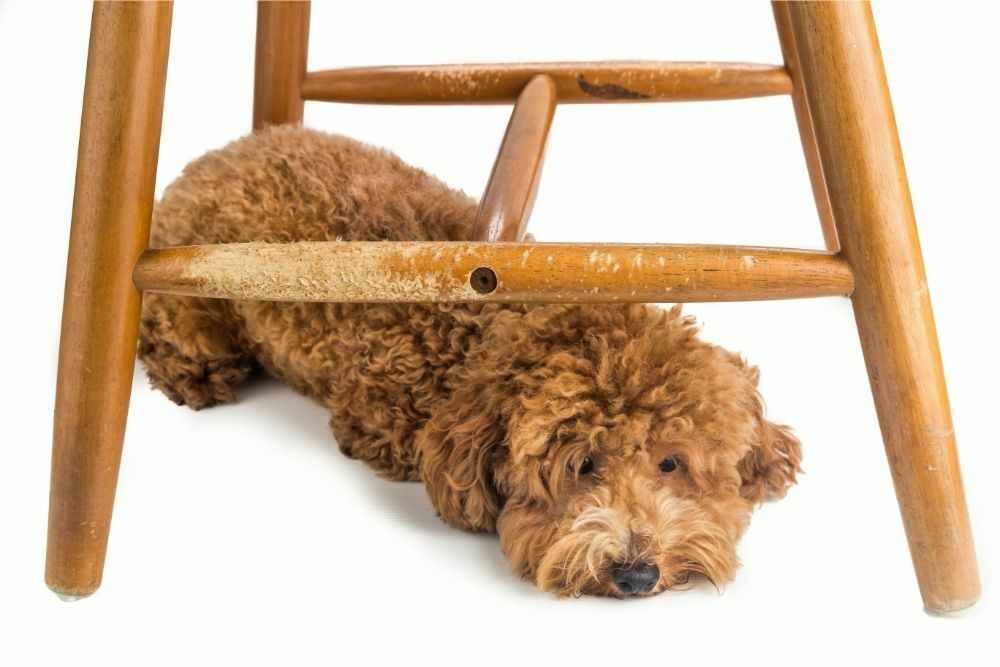
Of all the destructive behaviors that dogs can display, there’s nothing quite as annoying as finding that your wood trim has been chewed up.
It’s not only damaging to our homes and expensive to repair, though. Chewing on wood trim can be dangerous for your dog. All it takes is for one particularly large splinter to work its way into your dog’s stomach and you’ll be headed to the veterinarian’s office with a potentially fatal injury.
Whether you’ve got a brand new inquisitive puppy or a rescue dog that needs a little help reestablishing some house rules, we’ll take a look at how to stop a dog from chewing on wood trim. We’ll explore some of the reasons why your canine companion may feel the need to chew, as well as some tips and tricks on how to stop it once and for all.
Why do dogs chew on wood trim?
As with most things, prevention is the best cure. So, the first thing we need to look at is why your dog chews on wood trim.
The first reason is their natural curiosity. A dog’s mouth is its main tool for exploring the world around them. In the same way that humans have hands to feel different textures, dogs have to use their mouths. And, to do this, they need to give everything a good lick and a chew to determine what it is, and whether it’s something they should avoid.
Puppies are much more inquisitive than older dogs and they also go through a destructive chewing phase. Think of it as a toddler throwing a tantrum! Like children, puppies also lose their first set of teeth, and they go through the teething process during this time. Chewing on certain things, including wood trim, helps to relieve the discomfort of their adult teeth growing through their gums.
As a dog grows from a puppy into an adult, the destructive chewing usually goes away. But, if you’re finding that your dog is still chewing on wood trim despite coming through the teething process and being old enough to lose their naturally destructive tendencies, there may be bigger issues at hand.
Below, we’ll take a look at some of the reasons why your dog may still be chewing on wood trim.
- Dental Issues: We know that a puppy might chew on wood trim to relieve the pain associated with teething. However, if an adult dog is chewing on wood trim, it could be that they are suffering from painful dental issues and are looking for a way to ease their discomfort. This could include swollen gums, loose teeth, or a variety of other problems.
- Stress or Anxiety: Just like humans, dogs get stressed from time to time and they cope by chewing. If your dog hates being left alone and suffers from separation anxiety, this could be the main reason why they are chewing on your wood trim.
- Natural Instinct: Certain breeds of dogs (such as retrievers and hunting dogs) have a natural instinct to chew on things. This is because they have a predisposition for holding things in their mouths.
- Boredom: If you leave your dog alone for long periods of time and don’t give them anything to keep themselves occupied, they’ll soon find a way of doing it themselves! And that wood trim or the corner of your favorite coffee table are all too tempting for a dog who has nothing else to chew on or play with. They might also be telling you in their own way that they need more exercise. After all, a tired dog will be more likely to sleep than chew on your wood trim.
- Pica: Pica is a health condition that compels a dog to ingest non-food items. This includes dirt, rocks, and, you guessed it, wood trim. They might even take to eating insects. The cause of Pica is poor nutrition or an intestinal parasite. So, if you’re certain none of the issues above a why your dog is chewing wood trim, it’s definitely worth taking them to the veterinarian and having them checked out for Pica.

Ways to Stop Your Dog Chewing on Wood Trim
If you think you’ve pinpointed the reason for your dog’s destructive behavior using the advice outlined above, it’s time to start thinking about how you can stop it. Below, we’ll take a look at some of the best ways to stop your dog from chewing on wood trim.
- Give your dog plenty of chew toys
Put simply, if your dog has something more appealing to chew on, they’ll be more likely to leave your wood trim alone. It’s an easy solution, and it’s one that’s definitely worth doing. There are a few things to keep in mind, though.
First of all, you need to make sure that the chew toys you’re giving them are appealing. Some chew toys are scented and flavored, making them even more tempting to chew on. Some have compartments that you can stuff with treats, giving your dog something to chew on and keeping them mentally stimulated at the same time. If your dog is motivated by food, these are definitely the best options to go for.
It’s also a good idea to choose chew toys with different textures and that provide different sensory experiences. Mix up stuffed toys, hard chews, and toys that include squeakers.
Woven ropes are also great for keeping your dog away from wood trim. If you’ve got more than one dog, they’ll soon find that they can keep themselves entertained with a game of tug of war, too!
- Give your dog plenty of attention and exercise
A tired dog is much less likely to exhibit destructive behavior as they’ll choose their downtime to go to sleep. If you’re finding that your dog is chewing your wood trim while you’re out of the house, take some time to take them for a long walk directly before you need to leave for the day.
It’s also important to keep them mentally stimulated, as this can be just as exhausting as physical exercise. Puzzle toys are a good tool for doing this, and you can even leave them to get on with them while you’re out of the house.
A dog will also get both mental stimulation and exercise from socializing with other dogs. You don’t necessarily have to add another dog to your household to do this, though. Instead, contact a local dog walker and ask them to take them out with other dogs for a couple of hours a day.
- Use a deterrent spray
Spraying your wood trim with a deterrent spray may seem like an extreme measure to go to, but it’s an effective way to stop a dog from chewing on it if other methods haven’t been successful.
A deterrent spray will taste disgusting to your dog, so as soon as they begin chewing on the wood trim, they’ll stop as they learn it’s not something to enjoy. It is essential, however, that you’re using a deterrent spray that is dog-friendly. Grannick’s Taste Deterrent for Dogs is a great choice if you’re choosing this method.
- Create a physical barrier
Still struggling to have any success with toys and deterrent sprays? Or does your dog simply have so much energy that they’re still not exhausted after a long walk? You may need to create a physical barrier between them and your wood trim.
A dog crate is your best tool for doing this. Despite what may be said about them, dog crates can help your dog establish a place of their own, while simultaneously keeping them from chewing on wood trim.
You do need to ensure you get an appropriately sized crate for your dog. As a general rule, they should be able to stand up in it and turn in a complete circle. If they can’t do this, it’s too small.
If you’re not keen on the idea of using a crate, then a baby gate is another good tool for creating a physical barrier. These are easy to install and are particularly useful if your dog has been fixating on a certain item.
- Revisit their basic training
You might have to do this with rescue dogs in particular, as they may have forgotten some house rules while they’ve been waiting to be adopted. In some cases, they may never have learned any in the first place.
Luckily, it’s quite easy to train your dog so they learn what is acceptable and what isn’t. Whenever you see your dog headed toward your wood trim, or you see them chewing on it, say “No!” in a firm voice. Immediately following this, move them to another area and give them a toy to focus on instead.
You can also use positive reinforcement in the form of treats, treating them to a delicious dog biscuit when they head for their own toys rather than your wood trim. This will help them learn the difference between what they are allowed to chew on, and what they aren’t.
You do need to exercise some patience when it comes to training, though. Even the cleverest breeds of dogs will take a few weeks to fully realize what their limitations are. It’s important that you don’t allow yourself to get overly frustrated during this time, either. Yelling at your dog or hitting them will only make them scared of you, and that’s not something that you ever want to happen.
Why is it dangerous for a dog to chew on wood trim?
There are a couple of reasons why chewing on wood trim is dangerous for dogs. First of all, wood breaks apart very easily, especially under the pressure of a powerful dog’s jaw. As it splinters, the wood can get into your dog’s gums or get stuck between their teeth, which can lead to a painful (and expensive) injury.
Secondly, your dog may choose to swallow the wood they are chewing. This can cause blockages in the digestive system that may only be cured through surgery. In some cases, this can lead to a fatality.
It’s also worth noting that certain types of wood are treated with chemicals to ensure their durability. However, these chemicals aren’t designed for ingestion and, if eaten, could be toxic to your dog.
Final Word
So, there you have it, everything you need to know about why your dog is chewing on wood trim and how to stop it. If you have noticed that your dog is chewing on your wood trim, it’s incredibly important that you stop this behavior before it gets out of hand.
Go through some basic training, give them plenty of exercise, and provide them with a mixture of different toys to play with. Doing this will keep them mentally and physically occupied, and dramatically reduce the chances of them biting chunks out of your wood trim. If all else fails, create a physical barrier between your dog and your wood trim using a crate or a baby gate.
Taking these steps doesn’t only stop you from having to cover the expense of replacing it, but it could ultimately stop your dog from injuring themselves. It also stops your dog from causing damage to any homes that you’re visiting and generally helps to make sure they are a well-rounded member of society.
